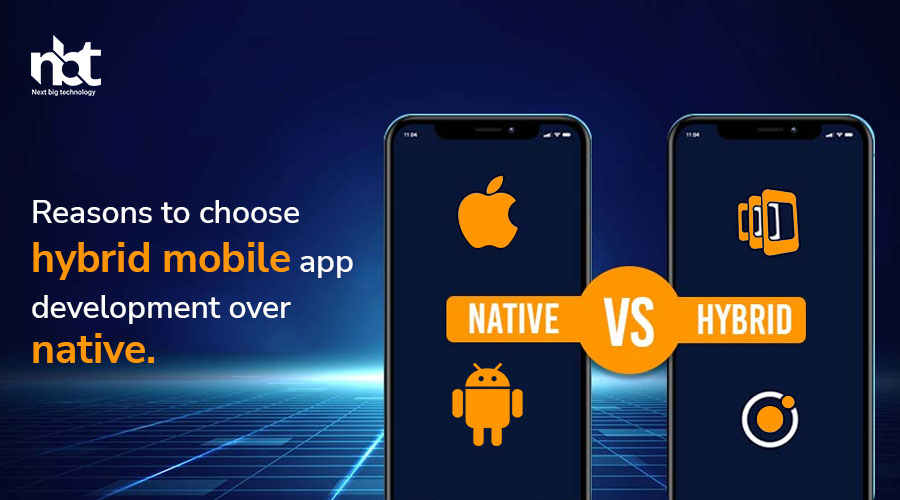Table of Contents
Understanding Hybrid Mobile App Development
In the realm of mobile app development, the ongoing debate between hybrid and native approaches continues to intrigue developers and businesses alike. Hybrid mobile app development has emerged as a compelling alternative, offering a unique amalgamation of features from both web and native applications. To comprehensively understand this approach, let’s delve deeper into the essence of hybrid mobile app development, its architecture, advantages, and considerations.
Defining Hybrid Mobile App Development:
Hybrid mobile apps are applications built using web technologies such as HTML, CSS, and JavaScript, encapsulated within a native container. This container allows the app to leverage the device’s native capabilities while running within a web view. Unlike native apps, which are specifically developed for a particular platform, hybrid apps aim to provide a consistent user experience across multiple platforms.
Architecture of Hybrid Mobile Apps:
1. Web View Component:
- The core of hybrid apps resides in the web view, typically a WebView component in iOS or WebView in Android. This web view displays the web content of the application, built using standard web technologies.
2. Native Container:
- A native wrapper, often created using frameworks like Apache Cordova, Ionic, or React Native, encapsulates the web view. This container facilitates communication between the web view and the device’s native features, enabling access to functionalities like camera, GPS, and sensors.
3. Hybrid Frameworks:
- Frameworks like React Native, Flutter, and Xamarin streamline the development process by allowing developers to write a single codebase that can be deployed across multiple platforms, enhancing efficiency and reducing development time.
Advantages of Hybrid Mobile App Development:
1. Cost-Efficiency:
- Building a hybrid app reduces development costs significantly compared to creating separate native apps for each platform. A single codebase for multiple platforms minimizes expenses related to maintenance, updates, and resources required for development.
2. Faster Development Time:
- Leveraging web technologies enables developers to reuse code across platforms, accelerating the development process. This quicker turnaround time enhances time-to-market, enabling businesses to seize opportunities swiftly.
3. Uniform User Experience:
- Hybrid apps offer a consistent user experience across various platforms, maintaining brand identity and usability standards. This consistency contributes to improved user engagement and loyalty.
4. Simplified Maintenance & Updates:
- With a single codebase, maintaining and updating hybrid apps becomes more straightforward. Changes or updates can be implemented across all platforms simultaneously, reducing complexities in the maintenance process.
5. Access to Device Features:
- Modern hybrid frameworks have evolved to offer improved access to native device capabilities. Frameworks like React Native and Flutter allow developers to access native functionalities, bridging the gap between hybrid and native app features.
6. Cross-Platform Compatibility:
- Hybrid apps’ ability to run on multiple platforms without major modifications ensures wider audience reach, catering to diverse user bases effectively.
Considerations and Challenges:
1. Performance:
- Hybrid apps might face performance issues compared to native apps, especially in scenarios demanding high graphics or extensive computational tasks.
2. Native Functionality Limitations:
- Despite advancements, certain complex native functionalities might be challenging to replicate entirely within a hybrid framework.
3. Framework Dependencies:
- Dependency on hybrid frameworks might lead to potential limitations or constraints, impacting the app’s scalability or access to cutting-edge native features.
Harnessing Cross-Platform Capabilities
In the rapidly evolving realm of mobile app development, the choice between native and hybrid approaches has been a long-standing debate. With businesses striving to reach a wider audience across diverse platforms while maintaining cost-efficiency and speed, the concept of harnessing cross-platform capabilities has emerged as a game-changer. This article aims to explore the significance and benefits of cross-platform development in the ever-expanding landscape of mobile applications within a 2000-word limit.
Understanding Cross-Platform Capabilities
Cross-platform development refers to the creation of mobile applications that can operate seamlessly on multiple operating systems and devices. It involves leveraging frameworks, tools, and technologies that enable developers to write a single codebase, which can be deployed across various platforms such as iOS, Android, and sometimes even web browsers.
The Evolution of Cross-Platform Development
Initially, native app development was the go-to choice due to its ability to leverage the full potential of a specific platform, resulting in high performance and optimal user experience. However, the drawbacks of native development, including higher costs and longer development cycles due to platform-specific code, prompted the emergence of cross-platform solutions.
Advantages of Cross-Platform Development
- Cost-Efficiency: One of the primary drivers for choosing cross-platform development is cost-effectiveness. Instead of investing in separate teams for different platforms, businesses can utilize a single development team and codebase, reducing overall expenses significantly.
- Faster Development: Cross-platform frameworks like React Native, Flutter, and Xamarin enable faster development by allowing developers to reuse code across platforms. This results in quicker deployment and time-to-market, giving businesses a competitive edge.
- Unified User Experience: Consistency across platforms is crucial for user satisfaction. Cross-platform development ensures a uniform user interface and experience, maintaining brand identity and usability standards across various devices and operating systems.
- Simplified Maintenance and Updates: Managing updates and maintaining the app becomes more streamlined with cross-platform development. Changes can be implemented across all platforms simultaneously, saving time and effort compared to updating separate native apps.
- Access to Device Features: Modern cross-platform frameworks provide access to native device features, blurring the lines between native and hybrid development. Developers can utilize APIs to incorporate device-specific functionalities seamlessly.
- Wider Market Reach: By targeting multiple platforms with a single codebase, businesses can expand their market reach and cater to a larger audience, tapping into diverse user bases without the need for extensive modifications or separate app versions.
Choosing the Right Cross-Platform Framework
Several frameworks facilitate cross-platform development, each with its strengths and suitability for specific project requirements:
- React Native: Known for its performance and flexibility, React Native, developed by Facebook, allows developers to build robust apps using JavaScript and React.
- Flutter: Google’s Flutter offers a rich set of pre-built widgets and a single codebase to create visually appealing and high-performance apps, utilizing Dart programming language.
- Xamarin: Owned by Microsoft, Xamarin enables developers to create cross-platform apps using C# and .NET, providing native-like performance and access to device-specific functionalities.
Challenges and Mitigations
While cross-platform development offers numerous advantages, it’s not without its challenges:
- Performance Concerns: Some argue that cross-platform apps may not match the performance of native apps. However, advancements in frameworks have significantly narrowed this performance gap.
- Framework Limitations: Each cross-platform framework has its limitations. Developers must carefully evaluate these limitations against project requirements and choose the most suitable framework.
- Platform-Specific Features: Integrating platform-specific features might pose challenges. However, most modern frameworks provide plugins or APIs to access native functionalities.
Native-Like Performance in Hybrid Apps
In the realm of mobile app development, the pursuit of achieving native-like performance in hybrid apps has been a focal point, sparking innovation and advancements in technology. Hybrid apps, leveraging web technologies like HTML, CSS, and JavaScript, have traditionally been scrutinized for their perceived performance gaps compared to their native counterparts. However, the landscape is evolving rapidly, with frameworks and methodologies emerging to bridge this performance divide. This exploration delves into the strategies, advancements, and tools empowering hybrid apps to emulate, and in some cases surpass, native app performance.
Understanding the Performance Gap
Native apps, tailored for specific platforms like iOS or Android, have long been lauded for their superior performance due to direct access to device hardware and native APIs. On the contrary, hybrid apps historically faced limitations in speed, responsiveness, and access to device functionalities due to their reliance on an additional layer—web views or containers—to render content.
The Evolution of Hybrid App Frameworks
The evolution of hybrid app development frameworks plays a pivotal role in closing the performance gap. Frameworks such as React Native, Flutter, and Xamarin have redefined hybrid app development by introducing mechanisms to achieve near-native performance.
- React Native: Leveraging React Native’s architecture, apps are built using native components while employing JavaScript to dictate the logic. This approach facilitates smoother performance by enabling direct communication with native modules, ensuring a more seamless user experience.
- Flutter: Google’s Flutter framework employs a different approach by utilizing a single codebase and compiling directly to native ARM code. This methodology eradicates the need for a JavaScript bridge, thereby enhancing performance and delivering visually rich, responsive apps.
- Xamarin: Microsoft’s Xamarin allows developers to build apps using C# and .NET, offering near-native performance by compiling code directly into native binaries. This grants access to native APIs, optimizing performance without compromising on functionality.
Optimization Techniques
Several optimization techniques have emerged to refine hybrid app performance:
- Code Optimization: Minification, tree shaking, and code splitting techniques reduce the app’s footprint and enhance loading times.
- Rendering Optimization: Employing virtual DOM (Document Object Model) concepts and efficient rendering strategies enhances UI responsiveness, mitigating performance bottlenecks.
- Hardware Acceleration: Utilizing hardware acceleration through libraries and optimized rendering engines ensures smoother animations and transitions, closely resembling native app behavior.
Access to Device Features
Traditionally, accessing native device features in hybrid apps posed challenges. However, advancements in frameworks now enable seamless integration with native functionalities:
- Native Modules: Frameworks like React Native facilitate the creation of custom native modules, allowing direct access to device APIs, sensors, and hardware features.
- Platform-Specific Code: Utilizing platform-specific code snippets enables developers to incorporate device-specific functionalities while maintaining a single codebase for the app.
Overcoming Performance Challenges
Despite advancements, challenges persist in achieving native-like performance in hybrid apps:
- Complexity: Advanced optimizations and integration of native functionalities can introduce complexity, impacting development timelines and maintenance efforts.
- Platform Updates: Synchronization with platform updates and ensuring compatibility across various OS versions and devices requires continuous effort and vigilance.
Access to Native Device Features
In the realm of mobile app development, the perennial debate between native and hybrid approaches has been a focal point for developers seeking to optimize functionality while maintaining efficiency. The narrative surrounding hybrid app development has undergone a significant evolution, particularly concerning its access to native device features—an area where traditional perceptions once placed native apps at an indisputable advantage. However, recent advancements have bridged this gap, empowering hybrid apps to harness native device features effectively. This comprehensive exploration delves into the mechanisms, advancements, and capabilities enabling hybrid apps to access and utilize native device features seamlessly.
Understanding Hybrid App Development
Hybrid apps, unlike their native counterparts, are developed using web technologies such as HTML, CSS, and JavaScript. These apps operate within a native container and leverage WebView, a simplified browser window within the app, to render the application content. This setup allows for cross-platform compatibility, enabling apps to function across multiple operating systems, thereby reducing development costs and efforts significantly.
Evolution of Hybrid App Access to Native Features
- Initial Limitations: Early iterations of hybrid app development faced limitations in accessing native device features. The gap between hybrid and native apps was palpable, especially in functionalities reliant on hardware-specific capabilities like GPS, camera, or sensors. This limitation led to the perception that native apps were superior in providing a seamless user experience due to their direct access to these features.
- Frameworks & Advancements: The advent of frameworks like React Native, Xamarin, and Flutter revolutionized hybrid app development. These frameworks introduced plugins and modules that facilitated access to native APIs, enabling developers to interact with device features directly. With these advancements, hybrid apps gained the capability to integrate functionalities like camera access, geolocation services, accelerometer, and more, blurring the lines between native and hybrid development.
Mechanisms Enabling Access to Native Device Features
- Plugin Architecture: Hybrid app frameworks incorporate plugin architectures that act as bridges between the app’s codebase and native APIs. These plugins facilitate communication between the JavaScript code and device-specific functionalities, allowing developers to access native features seamlessly.
- Native Modules & APIs: Frameworks like React Native offer native modules, which are reusable code blocks written in native languages (Objective-C, Java, etc.). These modules interface with the device’s native APIs, granting access to features that were once exclusive to native development.
- Third-Party Libraries & Wrappers: Developers leverage third-party libraries and wrappers to access native functionalities. These libraries provide pre-built components and APIs that enable integration with native device features without requiring extensive native code development.
Advantages of Accessing Native Device Features in Hybrid Apps
- Enhanced Functionality: By accessing native device features, hybrid apps can offer enhanced functionalities, ensuring a richer user experience. This access allows for seamless integration of device-specific capabilities, such as utilizing the camera for augmented reality features or leveraging GPS for location-based services.
- Performance Optimization: Direct access to native APIs enhances the performance of hybrid apps, mitigating the performance gap that existed between hybrid and native applications. Improved performance contributes to smoother user interactions and faster response times.
- Uniform User Experience: Access to native features enables developers to maintain a consistent user experience across different platforms. This consistency fosters brand identity and user loyalty, regardless of the device or operating system used.
- Efficient Development Cycle: Integrating native device features into hybrid apps streamlines the development process. Developers can leverage a single codebase to access various device functionalities, reducing development time and effort compared to building separate native apps for different platforms.
Challenges and Considerations
- Platform-Specific Variations: Despite advancements, certain device features may have platform-specific variations that require additional adjustments in hybrid app development. Ensuring uniform functionality across different platforms can pose challenges.
- Plugin Maintenance & Compatibility: The reliance on plugins and third-party libraries necessitates vigilant maintenance and updates to ensure compatibility with evolving operating systems and devices. Dependency on external resources might introduce complexities in app maintenance.
- Performance Optimization: While access to native features improves performance, optimizing these functionalities within the hybrid framework without compromising speed and responsiveness remains an ongoing challenge for developers.
Simplified Maintenance and Updates
In the bustling realm of mobile app development, the process of maintaining and updating applications stands as a critical aspect of ensuring their relevance, functionality, and user satisfaction. In this digital age, where rapid changes and innovations are the norm, the ability to streamline maintenance and updates is pivotal. Hybrid mobile app development emerges as a game-changer, offering a simplified and efficient approach to these crucial aspects compared to native development.
Hybrid mobile apps, built using web technologies like HTML, CSS, and JavaScript, provide a versatile platform that runs seamlessly across multiple operating systems, such as iOS and Android. This unique characteristic forms the cornerstone of simplified maintenance and updates in hybrid apps.
Maintenance Simplified
Single Codebase for Multiple Platforms
One of the most significant advantages of hybrid app development lies in its utilization of a single codebase for various platforms. Unlike native apps that require separate coding for each operating system, hybrid apps share a unified codebase. This unified approach greatly reduces the complexity associated with maintaining multiple versions of an application.
Efficient Bug Fixing and Issue Resolution
With a single codebase, addressing bugs, glitches, or issues becomes notably more efficient in hybrid apps. Developers can identify and rectify issues universally, ensuring that fixes apply uniformly across all platforms. This eliminates the need to debug and troubleshoot separately for each platform, expediting the maintenance process.
Streamlined Updates Across Platforms
Updating hybrid apps is a streamlined process facilitated by the shared codebase. When new features or improvements are implemented, these updates can be rolled out simultaneously across different platforms. This simultaneous deployment ensures uniformity and consistency in the user experience across various devices.
Updating Seamlessly
Expedited Feature Integration
Integrating new features into hybrid apps is expedited due to the unified codebase. Developers can seamlessly add functionalities without the complexities of adapting them individually for each platform. This agility in feature integration allows businesses to respond swiftly to market demands and user feedback.
Consistent User Experience
Maintaining a consistent user experience across different platforms is a significant challenge in native app development. However, hybrid apps, with their single codebase, ensure uniformity in the user interface and experience. Updates or changes made reflect consistently across all platforms, preserving the app’s identity and usability standards.
Time and Cost Efficiency
The streamlined process of updates and maintenance in hybrid apps translates to significant time and cost savings. Businesses can allocate resources more efficiently as the need for separate development teams or extensive debugging for different platforms is minimized. This efficiency contributes to quicker iterations and a faster time-to-market for updates and new versions of the app.
Overcoming Challenges
While hybrid mobile app development offers simplified maintenance and updates, it’s not without its challenges. Ensuring compatibility across various devices and platforms, as well as optimizing performance, remains a constant focus area for developers. Yet, advancements in hybrid app development frameworks like React Native and Flutter continue to bridge the gap, addressing these challenges and enhancing the capabilities of hybrid apps.
Cost-Efficiency in Development and Maintenance
In the realm of mobile app development, cost-efficiency stands as a pivotal factor influencing decision-making processes for businesses and developers alike. The emergence and evolution of hybrid mobile app development have presented a compelling case for cost-effectiveness throughout the development and maintenance lifecycle of applications. This article aims to thoroughly explore and dissect the intricate facets that render hybrid app development a financially prudent choice compared to native alternatives, emphasizing both development and maintenance phases.
Understanding Hybrid Mobile App Development
Before delving into the economic aspects, a brief understanding of hybrid app development is imperative. Hybrid apps combine elements of both web and native applications. They are built using web technologies like HTML, CSS, and JavaScript and are encapsulated within a native container that enables them to access device capabilities. This amalgamation allows hybrid apps to function across multiple platforms while retaining native-like functionalities.
Cost-Efficiency in Development
- Single Codebase, Multiple Platforms: The fundamental economic advantage of hybrid app development lies in its utilization of a single codebase that operates across multiple platforms (iOS, Android, etc.). Unlike native development, which necessitates separate coding for each platform, hybrid development significantly reduces the time, effort, and resources required for coding, resulting in substantial cost savings.
- Reduced Development Time: By leveraging frameworks like React Native or Flutter, developers can expedite the development process. These frameworks enable the reuse of code components across platforms, streamlining the coding process and shortening the development timeline. The accelerated development pace directly translates into cost savings by reducing labor hours and associated expenses.
- Lower Development Costs: Hybrid app development requires a smaller team of developers proficient in web technologies, as opposed to native development, which often demands specialized expertise for each platform. This streamlined team structure not only reduces labor costs but also diminishes the need for hiring platform-specific developers, contributing significantly to overall cost reduction.
- Ease of Testing: Hybrid apps facilitate easier testing processes. With a single codebase, quality assurance and testing procedures become more straightforward and less time-consuming. The unified testing approach ensures comprehensive bug identification and resolution, preventing costly post-release issues that might arise from platform-specific discrepancies.
Cost-Efficiency in Maintenance
- Unified Codebase for Updates: Maintenance of hybrid apps is notably cost-efficient due to the presence of a unified codebase. Updates or modifications can be implemented across all platforms simultaneously, eliminating the need for separate updates for each platform. This not only saves time but also minimizes maintenance costs associated with managing multiple codebases.
- Reduced Time for Fixes and Enhancements: Any fixes, enhancements, or feature additions can be executed swiftly across all platforms in hybrid apps. This agility in implementing changes translates to lower maintenance expenses, as developers can address issues promptly without the protracted process of making platform-specific adjustments.
- Mitigated Compatibility Challenges: Native apps often encounter compatibility challenges across different versions of operating systems or devices. Hybrid apps, however, mitigate these challenges to a significant extent by leveraging a uniform codebase. This reduces the need for extensive compatibility testing and subsequent maintenance efforts, resulting in cost savings.
Challenges and Considerations
While the cost-efficiency of hybrid app development is undeniable, it’s essential to acknowledge certain challenges and considerations:
- Performance Concerns: Hybrid apps might face performance limitations compared to their native counterparts, especially in scenarios requiring high graphical processing or complex computations. This could necessitate additional optimization efforts, potentially impacting cost-effectiveness.
- Balancing Native Functionality: Though hybrid frameworks offer access to native device functionalities, achieving a balance between native-like performance and cross-platform compatibility might require meticulous fine-tuning, which could entail additional development costs.
Mitigating Development Challenges
In the realm of mobile app development, the choice between hybrid and native platforms is a pivotal decision, often influenced by various factors like cost, time-to-market, and user experience. Hybrid mobile app development, leveraging both web and native technologies, offers a compelling middle ground. However, it’s not without its challenges. This article seeks to explore the common hurdles faced in hybrid app development and strategies to mitigate them, ensuring a smoother development journey.
- Performance Optimization: Historically, hybrid apps struggled to match the performance benchmarks set by native counterparts due to their reliance on web technologies. However, advancements in frameworks like React Native and Flutter have significantly bridged this gap. Employing techniques such as code optimization, minimizing DOM manipulation, and using native modules for critical functionalities helps enhance app performance.
- User Experience Consistency: Maintaining a uniform user experience across diverse platforms remains a challenge in hybrid app development. Differences in platform guidelines and UI components often lead to inconsistencies. Addressing this challenge involves meticulous design planning, utilizing adaptive UI components, and conducting thorough testing across various devices and operating systems to ensure a consistent and intuitive user experience.
- Access to Native Features: Earlier, hybrid apps faced limitations in accessing native device features. However, frameworks like Apache Cordova and Ionic now offer plugins that facilitate native feature integration. Additionally, utilizing platform-specific APIs and incorporating third-party libraries enables developers to harness native functionalities effectively, ensuring a seamless user experience.
- Debugging and Testing: Debugging and testing hybrid apps across multiple platforms can be complex. Tools like Chrome Developer Tools and Safari Developer Tools aid in debugging web aspects, while frameworks like Appium and TestFlight assist in cross-platform testing. Implementing rigorous testing protocols, automated testing suites, and leveraging real-device testing environments streamline the debugging and testing phases.
- Code Maintainability: With a single codebase catering to multiple platforms, maintaining code quality and cleanliness is crucial. Employing modular architecture patterns like MVC or MVVM and adhering to best coding practices ensures code readability, simplifies maintenance, and facilitates future updates and feature additions.
- Platform Fragmentation: The diversity of devices, screen sizes, and OS versions poses a challenge in ensuring app compatibility and performance consistency. Employing responsive design principles, adaptive layouts, and thorough device-specific testing helps mitigate platform fragmentation, ensuring a seamless experience across a myriad of devices.
- Security Concerns: Security vulnerabilities in hybrid apps can arise due to web-based components. Mitigating these concerns involves adopting encryption techniques for sensitive data, implementing secure communication protocols, and staying updated with security patches and best practices to fortify the app against potential threats.
- Vendor Lock-In: Dependency on third-party frameworks or tools can lead to vendor lock-in, limiting flexibility in the long run. To mitigate this, developers should evaluate and choose frameworks with strong community support, open-source nature, and robust documentation. Additionally, modularizing the codebase helps minimize dependencies, allowing easier transitions if needed.
Hybrid App Security Measures
Securing Hybrid Mobile Applications: Robust Measures for a Safe User Experience
Hybrid mobile applications have witnessed a surge in popularity due to their cross-platform compatibility and cost-effectiveness. However, with this rise in usage comes the imperative need for stringent security measures to safeguard sensitive user data and ensure a secure app environment. The unique nature of hybrid apps, which combines web technologies with native functionalities, necessitates a comprehensive approach to security. Here, we delve into the multifaceted strategies and best practices to fortify the security posture of hybrid mobile applications.
Understanding Hybrid App Security Challenges
Before diving into specific measures, comprehending the distinct challenges faced by hybrid apps is crucial. The hybrid nature introduces vulnerabilities that stem from both web and native components, creating a diverse landscape of potential security threats:
- Code Vulnerabilities: Hybrid apps rely on HTML, CSS, and JavaScript, which are prone to common web-based vulnerabilities like Cross-Site Scripting (XSS), Cross-Site Request Forgery (CSRF), and SQL Injection.
- Access to Native Features: Bridging native device functionalities within hybrid apps opens avenues for security risks. Improper handling of native APIs can lead to data breaches or unauthorized access to sensitive device features.
- Third-Party Plugins: Integrating third-party plugins or libraries poses a risk if they contain vulnerabilities or malicious code, potentially compromising the entire application.
Robust Security Measures for Hybrid Apps
1. Code-level Security Best Practices:
- Input Validation and Sanitization: Implement stringent input validation to prevent injection attacks like XSS and SQL Injection. Sanitize user inputs to eliminate malicious code.
- Secure Coding Standards: Adhere to secure coding standards, avoid hardcoded credentials or sensitive information in the codebase, and regularly update dependencies to mitigate known vulnerabilities.
2. Data Encryption and Storage:
- Secure Data Transmission: Utilize HTTPS and SSL/TLS protocols to encrypt data during transmission, ensuring confidentiality and integrity.
- Secure Data Storage: Employ encryption techniques for sensitive data stored locally on the device. Utilize platform-specific secure storage mechanisms and avoid storing sensitive data in plain text.
3. Access Control and Authentication:
- Implement Strong Authentication: Enforce robust authentication mechanisms like multi-factor authentication (MFA) to validate user identity and deter unauthorized access.
- Access Permissions: Limit access to native device features by employing proper permission models. Request access only when necessary and clearly communicate to users why certain permissions are required.
4. Secure Backend Integration:
- API Security: Validate and secure APIs to prevent attacks like injection, tampering, or unauthorized access. Implement techniques like API keys, authentication tokens, and rate limiting.
- Third-Party Libraries: Vet third-party libraries rigorously for security vulnerabilities before integration. Regularly update and patch these libraries to address known security flaws.
5. Continuous Security Testing and Monitoring:
- Penetration Testing: Conduct regular penetration tests and security audits to identify and address vulnerabilities proactively.
- Real-time Monitoring: Implement robust monitoring tools to detect anomalous behavior, potential threats, and unauthorized access in real-time.
6. Secure Update Mechanisms:
- Patch Management: Ensure timely and secure delivery of updates and patches to address identified security vulnerabilities. Implement mechanisms for automatic updates to mitigate risks promptly.
7. Compliance with Industry Standards:
- Adherence to Regulations: Stay compliant with relevant data protection regulations like GDPR, HIPAA, or CCPA, depending on the nature of the application and the user data it handles.
Hybrid Development Frameworks and Tools
Hybrid Development Frameworks and Tools: Empowering Cross-Platform App Development
In the realm of mobile app development, the choice of framework and tools plays a pivotal role in crafting applications that resonate across diverse platforms. Hybrid development, blending the prowess of web technologies with native capabilities, has surged in popularity. This approach harnesses frameworks and tools that facilitate the creation of cross-platform applications, offering efficiency, cost-effectiveness, and broader reach. Let’s delve into some prominent hybrid development frameworks and tools revolutionizing the landscape of app creation.
I. Ionic Framework
Overview: Ionic stands as a frontrunner in hybrid app development, leveraging web technologies like HTML, CSS, and JavaScript. This open-source SDK offers a comprehensive library of components, enabling developers to craft visually appealing, high-performance applications.
Key Features:
- Cross-Platform Compatibility: Ionic allows the creation of apps that function seamlessly across multiple platforms, ensuring a consistent user experience.
- UI Components: Its extensive library provides a plethora of UI components, facilitating the development of engaging interfaces.
- Cordova/PhoneGap Integration: Ionic seamlessly integrates with Cordova or PhoneGap plugins, granting access to native device functionalities.
- Community Support: With a vibrant community, developers find ample resources, plugins, and support forums, expediting the development process.
II. React Native
Overview: React Native, an offspring of Facebook’s React, has gained immense popularity for its ability to build native-like experiences using JavaScript and React.
Key Features:
- Native Performance: React Native employs a “learn once, write anywhere” approach, ensuring near-native performance by allowing developers to write in JavaScript while leveraging native components.
- Hot Reloading: Its hot reloading feature enables real-time preview of changes, accelerating the debugging and development process.
- Large Ecosystem: With a vast ecosystem of libraries and tools, React Native offers flexibility and extensibility, allowing developers to enhance app functionalities.
III. Flutter
Overview: Developed by Google, Flutter is a UI toolkit for crafting natively compiled applications for mobile, web, and desktop from a single codebase.
Key Features:
- Single Codebase: Flutter’s single codebase facilitates the creation of apps for multiple platforms, ensuring consistency and minimizing development efforts.
- Widgets and Customization: Its rich set of customizable widgets enables the creation of expressive and interactive interfaces.
- High Performance: Flutter’s architecture enables high performance by compiling directly to native code, delivering near-native performance across platforms.
- Hot Reload: Similar to React Native, Flutter supports hot reload, allowing developers to instantly view changes during the development process.
IV. Xamarin
Overview: Acquired by Microsoft, Xamarin empowers developers to build cross-platform apps using C# and .NET, sharing a significant portion of code across platforms.
Key Features:
- Native-Like Performance: Xamarin allows access to native APIs, providing native-like performance and functionality.
- Code Reusability: Developers can share up to 90% of code across iOS, Android, and Windows platforms, reducing development time and effort.
- Microsoft Integration: Being part of the Microsoft ecosystem, Xamarin integrates seamlessly with Visual Studio and Azure, offering robust development and deployment capabilities.
V. Adobe PhoneGap (Apache Cordova)
Overview: Adobe PhoneGap, built on Apache Cordova, enables the development of cross-platform mobile applications using HTML, CSS, and JavaScript.
Key Features:
- Easy Development: PhoneGap simplifies the development process by allowing developers to create apps using web technologies and a single codebase.
- Native Device Access: Leveraging Cordova plugins, PhoneGap grants access to native device functionalities, such as camera, geolocation, and more.
- Fast Prototyping: It facilitates rapid prototyping and testing across multiple platforms, expediting the development lifecycle.
VI. NativeScript
Overview: NativeScript enables developers to build native mobile apps using JavaScript, TypeScript, or Angular, sharing a single codebase across iOS and Android platforms.
Key Features:
- Native UI: NativeScript provides direct access to native APIs, allowing developers to create apps with native UI components and performance.
- Code Reusability: With code sharing, developers can reuse a significant portion of code across different platforms, optimizing development efforts.
- Angular Integration: For Angular developers, NativeScript offers seamless integration with Angular, enabling the creation of robust applications.
VII. Framework7
Overview: Framework7 is a full-featured HTML framework for building iOS and Android apps with a native look and feel.
Key Features:
- iOS and Android Themes: Framework7 offers iOS and Material Design themes, allowing developers to craft apps with native-like appearances for both platforms.
- Extensive UI Components: Its vast collection of UI components simplifies app development, offering ready-to-use elements for faster prototyping.
- Focused on Performance: Framework7 emphasizes performance, ensuring smooth animations and interactions for a native-like experience.
VIII. Appcelerator Titanium
Overview: Appcelerator Titanium allows the development of native-like mobile apps using JavaScript, utilizing a single codebase across iOS, Android, and Windows platforms.
Key Features:
- Native Access: Titanium offers direct access to native APIs, enabling developers to leverage device functionalities without compromising performance.
- Alloy MVC Framework: Its Alloy MVC framework streamlines development by providing a structured approach, enhancing code organization and reusability.
- Analytics and Cloud Services: Appcelerator integrates analytics and cloud services, facilitating app management, monitoring, and optimization.
IX. Sencha Touch
Overview: Sencha Touch is a JavaScript framework enabling developers to create mobile web applications with a native look and feel.
Key Features:
- Rich UI Components: Sencha Touch offers a wide array of UI components, allowing developers to build feature-rich and visually appealing applications.
- Native Packaging: It supports native packaging through tools like Cordova/PhoneGap, enabling the deployment of apps to app stores.
- High Performance: Sencha Touch emphasizes performance optimization, ensuring smooth and responsive user experiences.
X. Onsen UI
Overview: Onsen UI is an open-source UI framework for hybrid and mobile web apps, focusing on performance and ease of use.
Key Features:
- Customizable Components: Onsen UI provides a range of customizable UI components, enabling developers to create tailored interfaces.
- Angular and React Integration: It seamlessly integrates with Angular and React frameworks, offering flexibility to developers familiar with these technologies.
- Performance Optimization: Onsen UI prioritizes performance optimization, ensuring smooth and efficient app functionality.
Real-World Use Cases and Success Stories
- Instagram Use Case: Instagram, a leading social media platform, initially launched as an iOS-exclusive app. However, to expand its user base, they ventured into Android devices. Instead of developing separate native apps, Instagram opted for a hybrid approach using React Native, enabling them to maintain a consistent user experience across both platforms. Success Story: This strategic move allowed Instagram to swiftly penetrate the Android market while ensuring a seamless interface akin to its iOS counterpart. The decision to adopt a hybrid approach significantly reduced development time and resources, helping Instagram rapidly gain millions of Android users.
- Uber Use Case: Uber, the global ride-hailing giant, faced the challenge of providing a consistent experience across various mobile platforms. To address this, they adopted a hybrid approach, leveraging React Native for their driver app, ensuring compatibility and unified functionality across iOS and Android devices. Success Story: By employing a hybrid framework for their driver app, Uber streamlined development efforts, facilitating simultaneous updates across platforms. This consolidation led to faster feature rollouts, smoother user experiences, and improved operational efficiency for drivers.
- Walmart Use Case: Walmart, a retail giant, sought a solution to offer a cohesive shopping experience across different devices. They embraced hybrid app development to create a unified platform for their customers, employing technologies like React Native to build their app. Success Story: Walmart’s hybrid app approach allowed them to expedite the development process and maintain a consistent user interface across iOS and Android. This unified shopping experience resulted in increased user engagement, higher conversion rates, and improved customer satisfaction.
- Trello Use Case: Trello, a project management tool, aimed to cater to a diverse user base across multiple platforms efficiently. They chose a hybrid approach using technologies like React and Electron to ensure a seamless experience on desktop and mobile devices. Success Story: Trello’s hybrid strategy enabled them to deliver a consistent user experience across various platforms while reducing development efforts. This approach facilitated quicker updates and feature enhancements, fostering user loyalty and satisfaction.
- Flipkart Use Case: Flipkart, an e-commerce giant in India, faced the challenge of providing a uniform shopping experience across different devices and platforms. They embraced a hybrid approach using React Native to bridge the gap between iOS and Android users. Success Story: Flipkart’s hybrid strategy enabled them to streamline development efforts, reduce time-to-market, and maintain a consistent brand experience. This resulted in increased user engagement, higher conversion rates, and a competitive edge in the e-commerce market.
- SoundCloud Pulse Use Case: SoundCloud, a popular music streaming platform, wanted to provide creators with a dedicated app to manage their profiles. They opted for a hybrid approach using React Native to build SoundCloud Pulse, a platform catering to artists and content creators. Success Story: By leveraging hybrid development, SoundCloud could expedite the app’s release, allowing creators to manage their accounts seamlessly across iOS and Android devices. This consolidated approach boosted user engagement and empowered creators to manage their content efficiently.
Hybrid vs. Native: Making the Right Choice
Understanding Hybrid and Native Mobile App Development
Native Mobile App Development
Native apps are built for specific platforms using platform-specific programming languages and tools (Swift or Objective-C for iOS, Java or Kotlin for Android). These apps are optimized to leverage the full spectrum of functionalities and features offered by the operating system.
Hybrid Mobile App Development
Hybrid apps, on the other hand, are developed using web technologies like HTML, CSS, and JavaScript. These apps are encapsulated in a native container, allowing them to run across multiple platforms. Frameworks like React Native and Flutter enable developers to create hybrid apps that can access native device features.
Key Considerations in Choosing Between Hybrid and Native
Performance
Native apps typically outshine hybrids in terms of performance due to their ability to directly access device-specific hardware and software. However, advancements in hybrid app frameworks have significantly narrowed this gap, providing near-native performance for many applications.
Development Time and Cost
Building native apps for different platforms requires separate codebases and expertise in different languages, leading to increased development time and costs. Hybrid apps, with their shared codebase across platforms, expedite development and significantly reduce costs, making them an attractive option for businesses with budget constraints.
User Experience
Native apps often offer a seamless user experience by aligning with the platform’s design principles and guidelines. However, hybrid apps have evolved to provide consistent and intuitive user experiences across platforms, ensuring brand coherence and ease of use.
Access to Device Features
Historically, native apps had an advantage in accessing device-specific features. Yet, modern hybrid frameworks bridge this gap by offering plugins and modules that allow hybrid apps to access device features almost as efficiently as native apps.
Maintenance and Updates
Hybrid apps offer streamlined maintenance and updates as changes can be implemented across all platforms simultaneously due to their shared codebase. Conversely, native apps require separate updates for each platform, making maintenance more time-consuming and resource-intensive.
Scalability and Flexibility
Hybrid apps, with their single codebase, are highly scalable and adaptable to changing business needs. This flexibility allows for quick iterations, additions, and modifications without major overhauls in the development process.
Cross-Platform Compatibility
The inherent advantage of hybrid apps lies in their ability to run uniformly across multiple platforms, enabling wider audience reach and reducing the need for platform-specific modifications or versions.
Making the Right Choice
The decision between hybrid and native app development hinges on various factors, each carrying its weight in different scenarios.
- Complexity of the App: For simple to moderately complex apps where performance isn’t the utmost priority, hybrid development provides a cost-effective and efficient solution.
- Performance-Centric Apps: Applications heavily reliant on device-specific features or demanding high-performance levels may benefit from native development to ensure optimal performance.
- Budget and Time Constraints: When faced with limited resources and tight schedules, opting for hybrid development allows for quicker deployment and cost savings.
- User Experience Requirements: If delivering a native-feel user experience across different platforms is crucial, native development might be the preferred route.
- Long-Term Vision and Scalability: Hybrid apps offer scalability and adaptability, making them suitable for businesses planning iterative updates and expansions.
Expert Insights and Recommendations
Expert Insights: Unveiling the Benefits of Hybrid Mobile App Development Over Native
In the ever-evolving landscape of mobile app development, businesses face a critical decision when choosing between hybrid and native app development. Each approach presents unique advantages and challenges. However, the paradigm shift towards hybrid app development has been remarkable, and it’s crucial to understand the nuances that make this approach increasingly appealing in various scenarios.
The Essence of Hybrid Mobile App Development
Hybrid mobile apps combine elements of both web and native applications. They leverage web technologies like HTML, CSS, and JavaScript, encapsulated within a native container. This framework enables developers to build a single app that can run on multiple platforms, reducing development time and costs associated with creating separate native apps for iOS and Android.
1. Cost-Efficiency and Time-to-Market Advantage
The cost factor is a significant driving force behind the preference for hybrid app development. By adopting a single codebase for multiple platforms, businesses can significantly cut down on development costs and resources. This consolidated approach also expedites the time-to-market, allowing companies to seize market opportunities swiftly.
2. Unified User Experience and Brand Consistency
Hybrid apps offer a consistent user experience across platforms. This uniformity maintains brand identity and usability standards, enhancing user satisfaction and loyalty. Unlike native apps that often differ in design and functionality across platforms, hybrid apps ensure a seamless experience for users, irrespective of the device or platform they use.
3. Simplified Maintenance and Updates
Managing updates and maintenance for hybrid apps is simpler due to the single codebase. Developers can implement changes or updates across all platforms simultaneously, eliminating the need for separate rollouts. This streamlines the process, ensuring uniformity and reducing complexities in maintaining the app.
4. Enhanced Access to Device Features
Traditionally, native apps held an advantage in accessing device features. However, advancements in hybrid frameworks like React Native and Flutter have bridged this gap. These frameworks allow hybrid apps to tap into native device capabilities like GPS, camera, and sensors, providing a more robust user experience.
5. Cross-Platform Compatibility and Reach
Hybrid apps’ ability to run on multiple platforms ensures wider audience reach. Businesses can cater to diverse user bases without extensive modifications or the need for separate versions for different platforms. This broad compatibility significantly extends the app’s market reach.
Recommendations and Best Practices
1. Assess App Requirements Carefully
Before opting for a development approach, thoroughly assess the app’s requirements and objectives. Consider factors like performance needs, required functionalities, and target audience. While hybrid apps offer broad compatibility, if the app demands high performance or heavily relies on native functionalities, native development might be more suitable.
2. Optimize for Performance
Performance optimization is crucial for hybrid apps. Although advancements have narrowed the performance gap between hybrid and native apps, meticulous optimization is necessary to ensure a smooth user experience. Employing efficient coding practices and leveraging platform-specific features can enhance performance significantly.
3. Utilize Frameworks and Tools Wisely
Choose the right hybrid development frameworks and tools based on project requirements. Frameworks like React Native, Ionic, or Flutter offer distinct features and functionalities. Understanding the strengths of each framework and aligning them with project needs is key to successful hybrid app development.
4. Design with a User-Centric Approach
Maintain a user-centric approach during design and development. Focus on delivering a consistent and intuitive user experience across platforms. Prioritize usability, accessibility, and aesthetics to ensure user satisfaction and engagement.
5. Continuous Testing and Optimization
Implement a robust testing strategy to identify and rectify any issues across different platforms. Continuous testing and optimization are vital to maintaining app performance, stability, and security. Regular updates and bug fixes contribute to enhancing the overall app experience.
6. Embrace Scalability and Flexibility
Hybrid apps offer scalability and flexibility. Leverage these advantages by designing the app architecture to accommodate future enhancements and features. This scalability ensures the app remains adaptable to evolving business needs and technological advancements.
FAQs on Hybrid Mobile App Development
1. What is Hybrid Mobile App Development?
Hybrid mobile app development involves creating applications that function across multiple platforms (iOS, Android, etc.) using a single codebase. These apps combine elements of both web and native applications, leveraging web technologies like HTML, CSS, and JavaScript within a native container.
2. How does Hybrid Development differ from Native Development?
Native apps are built specifically for one platform using languages like Swift or Objective-C for iOS and Java or Kotlin for Android. In contrast, hybrid apps use web technologies and are then wrapped in a native container, allowing them to work across multiple platforms.
3. What are the key advantages of Hybrid App Development?
- Cost-Effectiveness: Developing a single hybrid app that works across platforms reduces costs compared to building separate native apps.
- Faster Development: Reusing code across platforms speeds up the development process, reducing time-to-market.
- Uniform User Experience: Hybrid apps provide consistent user experiences across different platforms.
- Simplified Maintenance: Updates and maintenance can be executed across all platforms simultaneously due to a single codebase.
- Access to Device Features: Advancements in frameworks allow hybrid apps to access native device features.
- Cross-Platform Compatibility: They can run on various platforms, broadening the audience reach.
4. What are the limitations of Hybrid App Development?
- Performance: Hybrid apps might have slightly lower performance compared to native apps, especially in resource-intensive tasks.
- Limited Native Features: Access to certain advanced or platform-specific features might be limited in hybrid development.
- Dependency on Third-Party Tools: The reliance on frameworks or third-party tools can sometimes affect app performance or stability.
- Complexity in Customization: Customizing the app to specific platform UI/UX guidelines might be more challenging.
5. Which frameworks are commonly used for Hybrid App Development?
- React Native: Developed by Facebook, it allows developers to build native apps using React and JavaScript.
- Flutter: Created by Google, it enables the creation of cross-platform apps with a single codebase in Dart.
- Ionic: A popular framework using HTML, CSS, and JavaScript to build hybrid mobile apps.
- PhoneGap/Cordova: Allows developers to build apps using web technologies and then wrap them in a native container.
6. How does Hybrid Development impact User Experience (UX)?
Hybrid apps aim to provide a consistent user experience across various platforms. However, achieving a seamless experience might require additional effort in design and development to meet each platform’s UI/UX guidelines.
7. Are Hybrid Apps suitable for all types of applications?
Hybrid apps are suitable for many types of applications, especially those that do not heavily rely on platform-specific functionalities or high-performance tasks. However, for apps demanding extensive use of device features or needing top-notch performance, native development might be preferred.
8. Can Hybrid Apps access native device features?
Yes, with advancements in frameworks like React Native and Flutter, hybrid apps can access various native device features such as GPS, camera, contacts, and sensors, bridging the gap between hybrid and native functionalities.
9. How do updates and maintenance work for Hybrid Apps?
Updates and maintenance are simplified in hybrid apps due to the single codebase. Changes or updates can be implemented across all platforms simultaneously, eliminating the need for separate rollouts for each platform.
10. Which factors should businesses consider when choosing between Hybrid and Native Development?
Factors such as the app’s complexity, required features, target audience, budget, and time constraints play a crucial role in choosing between hybrid and native development. If broader reach and cost-effectiveness are priorities, hybrid development might be preferable.
























